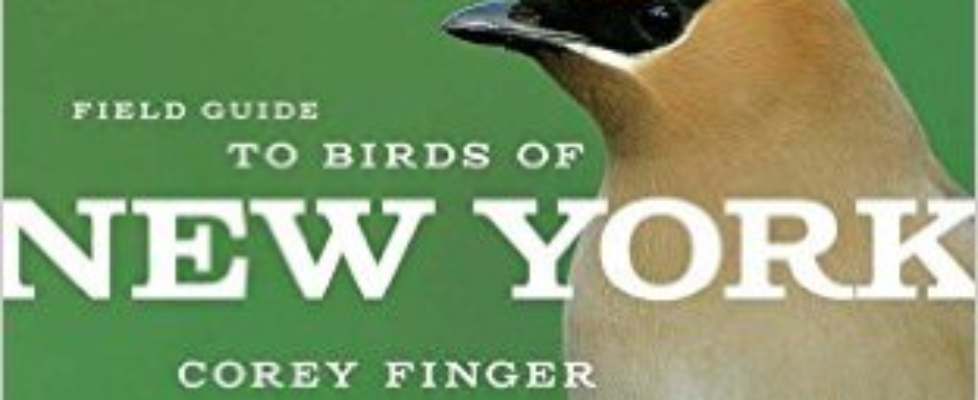Corey Finger & Birds of New York
Saw Mill River Audubon’s March 2017 public program featured Corey Finger, author of Birds of New York State. SMRA Board Member Brian Kluepfel wrote about this program.
Corey Finger didn’t start noticing birds until 2005—a Green Heron wading through the Five Rivers Environmental Education Center near Albany. Fascinated and perplexed, he used a Readers Digest North American Wildlife Guide to find out what he just saw—and he hasn’t stopped looking since.
Now the co-author of 10,000 Birds blog, so popular that he’s endorsed by the big-gun optics firm of Swarovsky, Finger has spread from his home turf of Queens through the Empire State, stalking the obvious and rare species with equal vigor. His enthusiasm for even the mundane robins and blue jays— “get as close as you can to the common stuff”—is contagious, as he showed at the Chappaqua Library on March 16.
A rapid-fire talker, it seemed that Finger showed us each of the 316 New York species he’s seen—from the Adirondacks, where he visits twice a year, to urban bird hotspots like Central Park, his home turf of Forest Park and Jamaica Bay, and even the small but bird-rich rectangle of Bryant Park, smack dab behind the New York Public Library on 42nd Street.
“You’ve got to be willing to take the time” to better your birding skills and counts, he said. He humorously recounted various oceanic exploits off Long Island in search of local pelagic, despite his recurring seasickness. “Paying money to spend hours vomiting is insane,” he laughed. But, as always, he got his birds, from terns to shearwaters to several gull species.
Among the common, he noted, you may spot the sublime, as he showed with different photos of oddities amidst abundance, like a Cackling Goose wedged in a flock of Canada Geese-another instance, he said, of species once considered one, now distinct items for your life list. You might see a Eurasian Teal (notable for its stripe) in with a flotilla of its North American cousins. On the other hand, he said, get your Hoary Redpoll documentation in now, for soon it will be reclassified with the common redpoll as only one bird.
What will he do to see a bird? Drive 7 hours across state for a rare Willow Ptarmigan. Take place in a “bit sit,” where you’re stuck on a porch-like structure all day, to see how many species you can tally (76, it turns out.) He’d even go all the way to Peru (Peru, New York that is) to catch a glimpse of a Northern Hawk Owl. His trips to the Adirondacks yield localized species like the Black-backed Woodpecker, the Spruce Grouse and the Gray Jay—hard to find in other parts of the state.
Then again, staying local has its rewards, if you have your eyes and iPhone open—and a MetroCard. Finger was among the many birders who saw two different kingbird species last year; one in the West Village and the other at Floyd Bennett Field in Brooklyn.
Unique sightings for Finger include a Gray-crowned Rosy-finch—a common Alaska-to-California species of which there are only 2 state records in New York—a Henslow’s Sparrow, and the Lewis’ Woodpecker (normally found west of the Great Plains, and named for the renowned explorer Meriwether Lewis, who secured a specimen in Idaho on his famed Corps of Discovery Expedition of 1804-06). With his high-end optics—he opts for the practice of digiscoping, or shooting a camera through a high-resolution spotting scope—his pictures are as outstanding as his sightings: A Least Bittern in flight over Long Island’s North Shore; the aforementioned Lewis’ Woodpecker; a Northern Saw-whet Owl which flew toward him in Prospect Park and perched just steps away.
Finger is no dabbler—four times he’s spotted more than 300 species in New York, although he doesn’t hold the state record of 362. He knows what time of year species are likely to be in certain places, increasing his likelihood of spotting them. And, for a year while writing Field Guide to the Birds of New York (American Birding Association), he didn’t sleep much. “Hey, you’ve got to get to Nickerson Beach before 8 am in June to see the terns feeding because after 8:00 it’s $35.00 to park!” But he says, “hunting down terns is great” and he’s seen as many as 9 species in a single beachcomb.
In addition to the vomiting, you might end up in less-than-desirable places. “Terns eat fish and they poo a lot, so you end up amongst this fish-poo smell,” he enthused, while the audience groaned. “But good spots often stink—you wind up near sewage plants or someplace where birds just congregate,” he said.
He joked about optimizing one’s birding by not having a job or a family, but Finger seems to be doing fine despite having one of each. And his helpful tips and genuine enthusiasm really won over the crowd, novices and veterans alike, who lined up to buy the $25.00 book afterward.
Thanks to Joan Kuhn at the Chappaqua Public Library and all my colleagues at SMRA for a fascinating program.
– Brian Kluepfel
American Birding Association’s Field Guide to the Birds of New York State. By Corey Finger; photographs by Brian E. Small. Scott & Nix, Inc., New York. ©2016.


